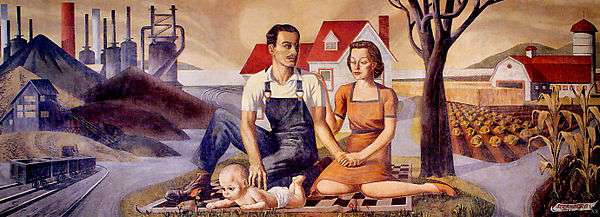Harry Sternberg
Harry Sternberg was an American painter, printmaker and educator. He was born in New York City on July 19, 1904 and died in Escondido, California on November 27, 2001.
Biography
Childhood, family life, and education
Sternberg's parents had immigrated from Russia and Hungary. The family moved to Brooklyn in 1910 and Harry began orthodox Jewish religious training. At the age of nine he began to take art classes at the Brooklyn Museum of Art. From 1922 until 1926 he trained at the Art Students League of New York.[1] He rented his first studio in Greenwich Village in 1926 and began his career in etching, printmaking and painting.
Early career
In 1931 his work was exhibited at The Whitney Museum of American Art for the first time. He was appointed in 1933 to the staff of the Art Students League of New York where he would remain an instructor for the next 35 years. The American painter Itshak Holtz was a student of Sternberg. After meeting Diego Rivera, the prominent Mexican muralist, and his wife Frida Kahlo in 1934 he became more politically active in union and socialist causes. In 1935 he was appointed a technical advisor to the Graphic Art Division, Federal Art Project (FAP). He was awarded a Guggenheim Fellowship in 1936 and spent the year studying the conditions of workers in coal mines and steel mills. His drawings, etchings and paintings depicting life in industrial America influenced his subsequent post office mural designs.
New Deal
In 1937 Sternberg painted his first post office mural, Carrying the Mail in Sellersville, Pennsylvania. The mural was commissioned by the former United States Department of the Treasury Section of Painting and Sculpture, later known as the Section of Fine Arts. Sternberg traveled to Chicago where he studied the city’s history, architecture, industry, and workers which resulted in his mural Chicago: Epoch of a Great City, for the Lakeview post office in Chicago. It depicts the history of the city from its first settlement of Fort Dearborn to the Great Fire to the life in the stock yards and the steel mills. In 1906 Upton Sinclair's novel, The Jungle, had graphically described life for workers in Chicago’s stockyards and steel mills and Sternberg strived to captured their struggle. In June 2001 a non-profit community organization, Friends of the Lakeview Post Office, was founded to facilitate a restoration of the mural. Parma Conservation of Chicago completed the work in 2003.[2]
"In participating in the WPA, I felt that I was part of one of the most vital and important cultural movements in America"[3]
He married Mary Gosney in 1939 and their family, including their baby daughter, are depicted in the Ambler, Pennsylvania post office mural, The Family, Industry and Agriculture. He was fond of self-portraits and painted his likeness into the scientist figure in his mural for the Lakeview post office.

Retirement
In 1966 he retired from the Art Students League and the Sternbergs moved to Escondido, California where he continued to work for 35 more years. In 1990 he published a collection of prints: Sternberg: A Life in Woodcuts, one of which depicts his painting of the Lakeview post office mural. In 2001 his life and work were celebrated by a major retrospective exhibition: No Sun Without Shadow: The Art of Harry Sternberg at the Museum–California Center for the Arts, Escondido, California. The catalog of this exhibition was researched and written by Ellen Fleurov the Museum director. Harry Sternberg died on November 27, 2001 in Escondido. He had previously written and published two books: a book on composition called Composition: The Anatomy of Picture Making, and a book on woodblock cutting and printing called WOODCUT.
See also
References
- ↑ "Gerald Garston, 68; artist known for mythic paintings of baseball" Boston Globe, April 5th, 1994 Search Result
- ↑ Bartholemew, Jim. "Steve Goodman Post Office". connectingthewindycity.com. Retrieved 20 November 2015.
- ↑ Becker, Heather (2002). Art for the People:The Rediscovery and Preservation of Progressive and WPA-era Murals in Chicago Public Schools, 1904-1943. Chicago, Il: Chronicle Books.
External links
- Figureworks.com/20th Century work at www.figureworks.com
- Comrades in Art: Harry Sternberg